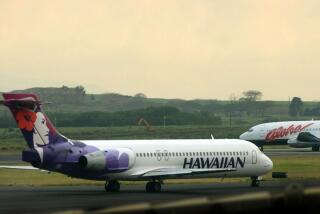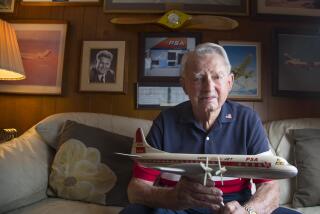TWA Merger Would Fulfill Longtime Goal of Running Major U.S. Air Carrier : Texas Air’s Lorenzo Closing In on Dream
- Share via
When Francisco A. Lorenzo tried to take over Trans World Airlines in 1979, many laughed. Lorenzo’s then-tiny Texas International Airlines, just 1/14th the size of its prestigious target, acquired about 4% of TWA’s stock but eventually backed down.
But today, no one is chuckling. With Lorenzo’s Texas Air Corp. agreeing Thursday to acquire TWA in what could be the nation’s largest airline merger ever, the maverick chief executive of the Houston-based firm moves even closer to his longtime dream of running one of the nation’s dominant airline systems.
For the record:
12:00 a.m. June 15, 1985 FOR THE RECORD
Los Angeles Times Saturday June 15, 1985 Home Edition Business Part 4 Page 2 Column 6 Financial Desk 1 inches; 22 words Type of Material: Correction
The Times incorrectly reported Texas Air Corp.’s 1984 net income as $27.8 million in a table in some of Friday’s editions. The correct amount is $50.3 million.
Texas Air’s $793.5-million bid is the latest chapter in the controversial saga of the 45-year-old Lorenzo, who--despite pulling off only one of four previous acquisition bids since 1979 while antagonizing many employees and competitors--has managed to survive and grow in the dog-eat-dog deregulated airline industry.
Analysts say the deal makes business sense, given that TWA’s routes and aircraft generally complement those of Texas Air’s primary subsidiary, Continental Airlines, and its other unit, New York Air. If completely merged, Texas Air and TWA would become the nation’s second-largest airline, behind United Airlines but slightly ahead of American Airlines, based on revenue. TWA alone currently ranks fourth behind American and Eastern airlines, while Continental alone ranks eighth.
Also, Continental’s finances have improved dramatically since its September, 1983, filing for reorganization under Chapter 11 of the U.S. Bankruptcy Code, a highly controversial move under which the airline abrogated its labor pacts, slashed wages nearly in half and cut two-thirds of its work force. However, making the deal work won’t be easy, the experts say. Lorenzo faces several hurdles that, if not surmounted, could put a significant financial strain on the combined company, they say.
“There are a lot of problems at TWA, and just because Lorenzo inherits them doesn’t mean they’ll automatically go away,” one Wall Street airline analyst said.
Perhaps the most challenging problem, analysts say, is TWA’s high costs, which, at about 7.9 cents per seat per mile, are among the highest in the industry and nearly 30% higher than the 6.2 cents estimated at Continental.
Lorenzo is almost certain to seek labor concessions to cut those costs. But two of TWA’s major unions, representing flight attendants and machinists, are balking at some of management’s demands for a lower wage structure and new work rules, and a strike is possible later this year.
Lorenzo is already considered an ogre by many union leaders due to his controversial cost-cutting tactics at Continental.
“Mr. Lorenzo’s reputation preceeds him. As far as labor relations, it is not totally positive,” said Vicki Frankovich, president of the Independent Federation of Flight Attendants, which represents 6,800 active TWA employees.
Also, merging Continental with TWA, which Lorenzo is expected to do eventually, would not be easy given the different seniority rights, work rules and other labor restrictions at the highly unionized TWA. By contrast, most of Continental’s employees are non-union.
Analysts also are concerned about Texas Air’s ability to finance the acquisition. Although Texas Air has between $150 million and $200 million in cash and supportive bankers, it may have trouble finding enough assets to use as collateral in any loans, said Timothy Pettee, a former manager of investor relations at Texas Air and now airline analyst for the Wall Street firm L. F. Rothschild, Unterberg, Towbin.
$400 Million in Cash
It is unlikely that Texas Air can use Continental’s assets to secure loans because those assets are already pledged to creditors as a result of Continental’s Chapter 11 filing, Pettee said.
“They may have to secure the loan with the assets of TWA,” he suggested. Analysts note that TWA has about $400 million in cash.
Nonetheless, many airline experts say the merger has a good chance of succeeding.
Since the airline industry was deregulated in 1978, the number of major carriers has been reduced through mergers and failures. Many industry leaders, including Lorenzo, believe that only a handful of major airlines will be big enough to survive into the 1990s and beyond, with the rest having to shrink or merge.
“This deal basically ensures that Texas Air will be one of those survivors,” Pettee said, adding that the Texas Air-TWA deal could be the start of the major new wave of airline mergers and acquisitions.
Although TWA’s domestic hub in St. Louis would compete with Continental’s hubs in Denver and Houston, Continental’s domestic routes could feed passengers to TWA’s international hub in New York. Continental’s international flights are primarily in the Pacific region, while TWA’s are across the Atlantic.
Frontier Airlines Faltering
Both carriers also operate complementary fleets of Boeing 727s and McDonnell Douglas DC-9s and MD-80s, which would minimize maintenance costs.
Continental’s financial fortunes have been strengthened by the weakening of Frontier Airlines, a major competitor at Continental’s Denver hub, and by the recent strike at United Airlines, another major rival at Denver.
Continental is now operating at 120% of its pre-bankruptcy flight level and is back in the black. It earned $50.3 million last year, compared to a loss of $218.4 million in 1983.
Thus, if Lorenzo can succeed in lowering TWA’s costs close to Continental’s, “he can just create incredible economics,” said the chief financial officer of a major airline.
Lorenzo’s TWA bid comes two months after Texas Air was spurned in a $186-million offer to buy Frontier Airlines. Frontier rejected the bid in part because it said the Justice Department would likely reject the merger on antitrust grounds.
Lorenzo, who once worked at TWA as a financial analyst in the mid-1960s, first entered the airline acquisition fray in 1972, when he and an associate bought a controlling interest in nearly bankrupt Texas International Airlines.
In 1979, Texas International attempted to take over much-larger National Airlines but was outbid by Pan American World Airways, although the Texas firm pocketed $19 million after taxes for selling its National shares. Soon later, Lorenzo lost his bid for TWA.
AIRLINE MERGER AT A GLANCE TRANS WORLD AIRLINES Trans World Airlines provides passenger and freight services in the United States, Europe and the Mediterranean. It became an independent company in February, 1984, when it was spun off by its former parent, Trans World Corp. in 1984, it carried 21.5 million passengers. Financial data for 1984 Revenue........................$3.7 billion Net income....................$29.9 million Current statistics Assets........................$2.88 billion Long-term debt................$1.20 billion Cities served...83 (64 domestic, 19 foreign Hubs....................New York; St. Louis Planes............159 (90 owned; 69 leased) Employees............................27,320 TEXAS AIR CORP. Texas Air Corp. is a holding company whose principal units are Continental Airlines and New York Airlines. Continental, which filed for reorganization under federal bankruptcy laws in September, 1983, and expects to submit a reorganization plan early next year, provides passenger and freight services in the United States, Central and South America and the South Pacific. New York Air founded in 1980, serves the Eastern United States. Texas Air also is seeking government approval for a new airline, Continental West. In 1984, Continental carried 10.9 million passengers and New York Air carried 2.8 million. Financial data for 1984 Revenue.....................................................$1.4 billion Net income.................................................$27.8 million Current statistics Assets......................................................$1.4 billion Long--term debt..............................................$315 million Cities served 86 (Continental: 46 domestic, 30 foreign; New York Air 10) Hubs..........................Houston and Denver (Continental); New York Planes..........................134 (Continental: 111; New York Air: 23) Employees..............12,380 (Continental: 11,000; New York Air: 1,380)
More to Read
Inside the business of entertainment
The Wide Shot brings you news, analysis and insights on everything from streaming wars to production — and what it all means for the future.
You may occasionally receive promotional content from the Los Angeles Times.










